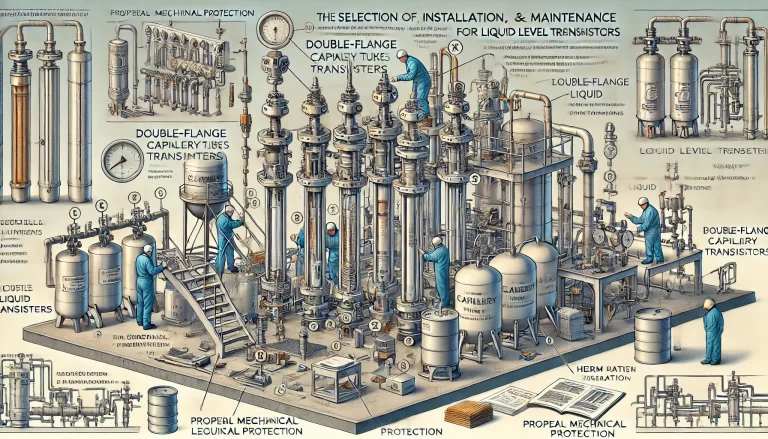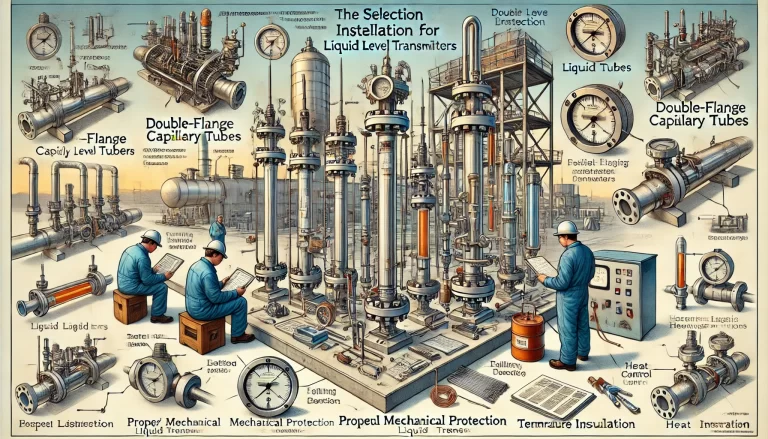To ensure the optimal operation and measurement accuracy of double-flange liquid level transmitters, special attention must be paid to the selection, installation, and maintenance of capillary tubes. Below are the detailed guidelines:
1. Selection of Capillary Tube and Filling Liquid
Choose the Appropriate Filling Liquid: Select the filling liquid based on the temperature requirements of the measured medium. For low-temperature environments, ensure the filling liquid’s freezing point is well below the ambient temperature. Common options include high-temperature silicone oil or low-temperature silicone oil.
Check Filling Liquid Properties: Verify the compatibility of the filling liquid with the measurement medium and environmental conditions to prevent chemical reactions or performance degradation.
2. Inspection of Filling Liquid
Pre-Installation Check: During transportation, use protective sleeves or secure fixtures to prevent physical damage to the capillary tube.
Leakage Inspection: Before installation, carefully inspect the capillary tube for signs of filling liquid leakage. If leakage is detected, replace the transmitter or capillary tube promptly. Leakage may result in significant measurement errors or complete failure of the liquid level transmitter.

3. Mechanical Protection
Handle with Care: Capillary tubes are fragile and must not be bent, twisted, or excessively compressed during installation.
Minimum Bending Radius: Ensure that the bending radius of the capillary tube meets or exceeds the manufacturer’s recommended minimum value. Excessive bending may lead to internal filling liquid leakage or poor pressure transmission.
4. Fixation and Structural Support
Proper Fixation: Secure the capillary tubes firmly to prevent displacement or damage caused by vibrations or external forces.
Avoid Excessive Length: The length of the capillary tube should generally not exceed 15 meters. Longer tubes can lead to additional errors caused by temperature variations.
Support Structures: Use durable materials, such as angle steel brackets, to provide mechanical protection.
5. Environmental Considerations
Temperature and Humidity Control: Install capillary tubes in areas with minimal temperature gradients and humidity fluctuations.
Thermal Insulation: Apply insulation measures to prevent external temperature changes from affecting the filling liquid. For instance:
High-temperature silicone oil capillary tubes should be insulated to avoid direct contact with heat sources, which could vaporize the filling liquid.
In extremely low outdoor temperatures, implement heat-tracing measures to prevent the filling liquid from freezing.
Avoid Overheating: When using heat tracing, ensure that the heat is moderate. Excessive heat could cause the filling liquid to vaporize, disrupting pressure transmission.

6. Routine Maintenance
Periodic Inspections: Regularly inspect the capillary tubes for mechanical damage, leaks, or signs of wear.
Performance Checks: Periodically verify the accuracy of measurements to ensure system reliability.
Immediate Repairs: Address any identified issues promptly to prevent prolonged inaccuracies.
7. Documentation and Training
Maintain a detailed record of the capillary tube specifications, installation conditions, and maintenance activities.
Train personnel on proper handling, inspection, and maintenance techniques to reduce human errors.
By adhering to these guidelines, the performance, longevity, and reliability of double-flange capillary tubes can be significantly enhanced, ensuring accurate measurements and reducing operational risks.
